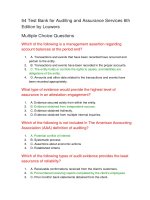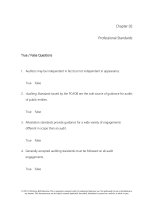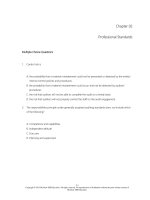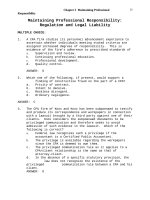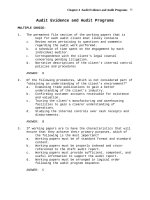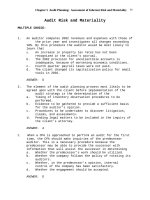TEST BANK AUDITING AND ASSURANCE SERVICES 5TH EDITION LOUWERS chap002
Bạn đang xem bản rút gọn của tài liệu. Xem và tải ngay bản đầy đủ của tài liệu tại đây (370.17 KB, 109 trang )
Chapter 02
Professional Standards
True / False Questions
1. Auditors may be independent in fact but not independent in
appearance.
True
False
2. Auditing Standards issued by the PCAOB are the sole source of
guidance for audits of public entities.
True
False
3. Attestation standards provide guidance for a wide variety of
engagements different in scope than an audit.
True
False
4. Generally accepted auditing standards must be followed on all audit
engagements.
True
False
5. The reporting principle relates to a firm's system of quality control
criteria for conducting an audit.
True
False
6. Auditors cannot effectively satisfy the responsibilities principle requiring
due care if they have not also satisfied the performance principle.
True
False
7. Substantive procedures performed by the audit team are most closely
related to the risk of material misstatement.
True
False
8. Auditing procedures are the same as auditing standards.
True
False
9. The concept of due care reflects the need to plan and perform the audit
with an appropriate level of professional skepticism.
True
False
10 Under the performance principle, auditors are required to provide
. absolute assurance that the client's financial statements do not contain
material misstatements.
True
False
11 The performance principle sets forth the quality criteria for conducting
. an audit.
True
False
12 Auditors of public entities registered with the Securities and Exchange
. Commission are required to register with the Public Company
Accounting Oversight Board.
True
False
13 Control risk is the probability that a material misstatement (error or
. fraud) could occur and not be prevented or detected on a timely basis
by the auditors' substantive procedures.
True
False
14 The word appropriateness refers to the number of transactions or
. components of an account balance examined by auditors.
True
False
15 To be considered material, an item must be one that would influence
. the decision of financial statement users.
True
False
16 The contents of the auditors' report are guided by the performance
. principle of GAAS.
True
False
17 An unqualified opinion indicates that the financial statements present
. the entity's financial condition, results of operations, and cash flows in
conformity with GAAP.
True
False
18 The auditors' report should either contain an expression of opinion on
. the financial statements taken as a whole or an assertion to the effect
that an opinion cannot be expressed.
True
False
19 Evidence is considered appropriate when it is both valid and relevant.
.
True False
20 The purpose of a system of quality control is to provide reasonable
. assurance that the firm and its personnel issue reports that are
appropriate under the circumstances.
True
False
Multiple Choice Questions
21 (Appendix) The attestation standards do not require the attestation
. report to include a statement that
A. Provides a conclusion whether the subject matter is presented in
conformity with established or stated criteria.
B. Indicates that the practitioner has significant reservations about the
engagement.
C. Identifies the subject matter or assertion being
reported on.
D. Indicates that the accountant assumes no responsibility to update
the report.
22 Control risk is
.
A. The probability that a material misstatement could not be prevented
or detected by the entity's internal control policies and procedures.
B. The probability that a material misstatement could occur and not be
detected by auditors' procedures.
C. The risk that auditors will not be able to complete the audit on a
timely basis.
D. The risk that auditors will not properly control the staff on the audit
engagement.
23 The responsibilities principle under generally accepted auditing
. standards does not include which of the following?
A. Competence and
capabilities.
B. Independent
attitude.
C. Due
care.
D. Planning and
supervision.
24 Which of the following types of auditors' reports does not require an
. explanatory paragraph to support the opinion?
A. Unqualified
opinion.
B. Adverse
opinion.
C. Qualified
opinion.
D. Disclaimer of
opinion.
25 Which of the following is an element of a system of quality control that
. should be considered by a public accounting firm in establishing its
quality control policies and procedures?
A. Lending credibility to a client's financial
statements.
B. Using statistical sampling
techniques.
C. Accepting and continuing client relationships and specific
engagements.
D. Obtaining membership in the Center for Public Company
Audit Firms.
26 Which of the following presumptions does not relate to the reliability of
. audit evidence?
A. The more effective the client's internal control, the more assurance it
provides about the accounting data and financial statements.
B. The auditors' opinion, to be economically useful, is formed within a
reasonable time and based on evidence obtained at a reasonable
cost.
C. Evidence obtained from independent sources outside the entity is
more reliable than evidence secured solely within the entity.
D. The independent auditors' direct personal knowledge, obtained
through observation and inspection, is more persuasive than
information obtained indirectly.
27 An important role of the Public Company Accounting Oversight Board is
. to oversee the
A. Issuance of statements by the Financial Accounting
Standards Board.
B. Preparation and grading of the Uniform CPA
Examination.
C. Peer review of member firms of the Private Companies Practice
Section.
D. Regulation of firms that audit public
entities.
28 Audit evidence is usually considered sufficient when
.
A. It is
reliable.
B. There is enough quantity to afford a reasonable basis for an opinion
on financial statements.
C. It has the qualities of being relevant, objective, and free from
unknown bias.
D. It has been obtained through random selection
methods.
29 Which of the following is not considered a type of audit evidence?
.
A. Entity's trial
balance.
B. Auditors'
calculations.
C. Physical
observation.
D. Verbal statements made by client
personnel.
30 (Appendix) The AICPA attestation standards differ from the
. responsibilities principle, performance principle, and reporting principle
in that:
A. The attestation standards contain no requirement to obtain an
understanding of the entity and assess the risk of material
misstatement.
B. The attestation standards do not require competence and
capabilities.
C. The attestation standards do not require planning for attestation
engagements or supervision of accountants and consultants who
perform the work.
D. The attestation standards do not require a report that states the
character of the engagement.
31 An audit of the financial statements of Camden Corporation is being
. conducted by external auditors. The external auditors are expected to:
A. Certify the correctness of Camden's financial
statements.
B. Make a complete examination of Camden's records and verify all of
Camden's transactions.
C. Give an opinion on the fair presentation of Camden's financial
statements in conformity with the applicable financial reporting
framework (e.g., GAAP, IFRS).
D. Give an opinion on the attractiveness of Camden for investment
purposes and critique the wisdom and legality of its business
decisions.
32 Auditors try to achieve independence in appearance in order to:
.
A. Maintain public confidence in the
profession.
B. Become independent in
fact.
C. Comply with the responsibilities
principle.
D. Maintain an unbiased mental
attitude.
33 The preparation of an audit plan prior to the beginning of fieldwork is
. appropriately considered documentation of
A. Plannin
g.
B. Supervisio
n.
C. Information
evaluation.
D. Quality
assurance.
34 Which of the following procedures would provide the most reliable audit
. evidence?
A. Inquiries of the client's accounting staff held in
private.
B. Inspection of prenumbered client shipping
documents.
C. Inspection of bank statements obtained directly from the client's
financial institution.
D. Analytical procedures performed by auditors on the client's
trial balance.
35 (Appendix) Which of the following is not an attestation standard?
.
A. The practitioner must obtain sufficient evidence to provide a
reasonable basis for the conclusion expressed in the report.
B. The practitioner must identify the subject matter or the assertion
being reported on and state the character of the engagement.
C. The practitioner must adequately plan the work and must properly
supervise any assistants.
D. A sufficient understanding of the client's internal controls shall be
obtained to plan the engagement.
36 Which of the following would most likely be a violation of the
. independence requirement found in the responsibilities principle under
generally accepted auditing standards?
A. An auditor on the engagement has a distant relative who is
employed by a vendor that does a significant amount of business
with clients.
B. The client's chief executive officer graduated from the same
university as the partner in charge of the accounting firm.
C. An auditor on the engagement owns a financial interest in the
client's stock.
D. The client provides financial support to a number of charitable
causes that also receive support from the accounting firm.
37 A vendor's invoice received and held by the client would be considered
. what type of evidence?
A. Externa
l.
B. Interna
l.
C. Externalinternal.
D. Written
representation.
38 Which of the following statements is generally correct about the
. appropriateness of audit evidence?
A. Auditors' direct personal knowledge obtained through observation
and inspection is more persuasive than information obtained
indirectly from independent outside sources.
B. To be reliable, audit evidence must be either valid or relevant but
need not be both.
C. Client accounting data alone may be considered sufficient
appropriate audit evidence to issue an unqualified opinion on client
financial statements.
D. Appropriateness of audit evidence refers to the amount of
corroborative evidence to be obtained.
39 The standard auditors' report refers to standards of the PCAOB and
. GAAP in which paragraph?
A. Standards of the PCAOB: Scope only; GAAP:
Opinion only
B. Standards of the PCAOB: Introductory only; GAAP: Scope and
opinion
C. Standards of the PCAOB: Introductory and scope; GAAP:
Opinion only
D. Standards of the PCAOB: Introductory only; GAAP: All
paragraphs
40 Which of the following is not included in the auditors' standard report
. representing an unqualified opinion?
A. A brief indication of the responsibility of auditors and management
for the financial statements.
B. An indication that all appropriate disclosures have been made and
included in the financial statements.
C. An indication that the audit was conducted in accordance with
standards established by the PCAOB.
D. The auditors' opinion on the fairness of the financial
statements.
41 Internal evidence
.
A. Is obtained directly from third parties independent of
the client.
B. Originates outside the client's system but has been received and
processed by the client.
C. Consists of documents that are produced, used, and stored within the
client's information system.
D. Consists of representations made by the client's officers, directors,
owners, and employees.
42 Which of the following presumptions is correct about the reliability of
. audit evidence?
A. Information obtained indirectly from outside sources is the most
reliable form of audit evidence.
B. To be reliable, audit evidence should be convincing rather than
persuasive.
C. Reliability of audit evidence refers to the amount of corroborative
evidence obtained.
D. An effective system of internal control provides more assurance
about the reliability of audit evidence.
43 The auditors' responsibility to express an opinion on the financial
. statements is
A. Implicitly represented in the auditors'
standard report.
B. Explicitly represented in the introductory paragraph of the auditors'
standard report.
C. Explicitly represented in the scope paragraph of the auditors'
standard report.
D. Explicitly represented in the opinion paragraph of the auditors'
standard report.
44 Which of the following is not a concept from the performance principle
. under generally accepted auditing standards?
A. The auditor must plan the work and properly supervise any
assistants.
B. The auditor must express an opinion in accordance with the
auditor's findings.
C. The auditor must obtain sufficient appropriate evidence about
whether material misstatements exist.
D. The auditor must determine and apply an appropriate materiality
level throughout the audit.
45 Under generally accepted auditing standards, which of the following
. relates to the responsibilities principle?
A. The initial planning of the audit
engagement.
B. The confirmation of accounts
receivable.
C. The completion of an internal control
questionnaire.
D. Maintaining professional skepticism and exercising professional
judgment.
46 Which of the following represent(s) audit quality guides that remain
. stable over time and are applicable for all audits?
A. Auditing
procedures.
B. Auditing
standards.
C. Due
care.
D. System of quality
control.
47 Which of the following situations would most likely be in conflict with
. the responsibilities principle?
A. Auditors perform the engagement with the performance level
expected of prudent auditors but not expert auditors.
B. Auditors obtain expertise in their client's industry as they are
conducting the audit examination.
C. Auditors are directly involved with a client manager in a strategic
decision-making capacity.
D. Auditors fail to document their assessment of control risk following
their study of internal control.
48 Which of the following statements is not true with respect to the
. evidence that would be gathered when assessments of control risk are
high?
A. Auditors would be required to rely on external (rather than internal)
forms of evidence.
B. Auditors would be required to perform procedures at interim periods
rather than at year-end.
C. Auditors would be required to confirm a larger number of customer
accounts receivable balances.
D. Auditors would be required to obtain more evidence through direct
personal observation.
49 As it relates to audit evidence, appropriateness refers to the
.
A. Originality of evidence
gathered.
B. Quality of evidence
gathered.
C. Quantity of evidence
gathered.
D. Timeliness of evidence
gathered.
50 Which of the following information would not be included in the
. auditors' standard report?
A. The names of the financial statements
audited.
B. A description of the nature of an
audit.
C. An indication that all necessary disclosures have been
presented.
D. An opinion on the entity's financial
statements.
51 The primary purpose of the auditors' study of internal control for a
. nonpublic entity is:
A. To provide constructive suggestions to the client for improving its
internal control.
B. To report on internal control as required by Auditing
Standard No. 5.
C. To identify and detect fraud and irregularities perpetrated by client
personnel.
D. To determine the nature, timing, and extent of substantive
procedures.
52 Which reporting options do auditors have if the client's financial
. statements are not presented according to the applicable financial
framework (e.g., GAAP, IFRS)?
A. Unqualified opinion or disclaimer of
opinion.
B. Qualified opinion or disclaimer of
opinion.
C. Unqualified opinion or adverse
opinion.
D. Qualified opinion or adverse
opinion.
53 Which of the following statements is true with respect to the
. persuasiveness of audit evidence?
A. Persuasiveness is related to the relevance of evidence but not the
reliability of evidence.
B. Evidence is considered more persuasive when gathered prior to yearend than following year-end.
C. Evidence obtained under environments of stronger internal control is
more persuasive than evidence obtained under environments of
weaker internal control.
D. In evaluating persuasiveness, sufficiency of evidence is of more
importance than appropriateness of evidence.
54 Which of the following concepts is least related to the risk of material
. misstatement?
A. Control
risk.
B. Detection
risk.
C. Inherent
risk.
D. Materialit
y.
55 Which of the following statements describes an appropriate relationship
. with respect to the reliability of audit evidence?
A. Receiving confirmation from third parties as to the existence of
securities is more reliable than the auditors' personal inspection of
those securities.
B. Verbal inquiries received from the client regarding sales made to
customers are more reliable than sales invoices prepared by the
client for its customers.
C. A bank confirmation received directly by the auditor is more reliable
than a bank confirmation initially received by the client and
forwarded to the auditor.
D. Evidence drawn from a document prepared by the client is more
reliable than evidence drawn from a document prepared by an
external party that is forwarded to the auditor by the client.
56 A periodic review of an audit firm's system of quality control by the
. PCAOB is referred to as a(n):
A. Inspectio
n.
B. Peer
review.
C. Principles
review.
D. Quality
review.
57 The performance principle would include all of the following except
.
A. The auditors' determination of materiality
levels.
B. The auditors' evaluation of independence with respect to
their clients.
C. The auditors' evaluation of the risk of material
misstatement.
D. The auditors' determination of the nature, timing, and extent of
substantive tests.
58 Which of the following is most closely associated with the
. responsibilities principle?
A. Due
care.
B. Plannin
g.
C. Qualified audit
opinion.
D. Risk of material
misstatement.
59 Which of the following statements is not true with respect to the
. responsibility for establishing generally accepted auditing standards?
A. The PCAOB issues auditing standards for the audit of public entities
subject to SEC approval.
B. Standards issued by the Auditing Standards Board after 2003 apply
to the audits of both public and private entities.
C. If not superseded by the PCAOB, Statements on Auditing Standards
issued prior to 2003 are applicable to the audit of public entities.
D. Prior to the Sarbanes-Oxley Act, the Auditing Standards Board issued
auditing standards for the audits of both public and private entities.
60 Which of the following would normally be considered earliest in the
. audit examination?
A. Determination of materiality levels to use during
the audit.
B. Consideration of the ability of the entity's internal control to prevent
or detect errors.
C. Preparation of a written audit
plan.
D. Evaluation of the type of audit opinion to be issued based on the
auditor's findings.
61 The state of mind that characterizes the auditors' appropriate
. questioning and critical assessment of audit evidence is referred to as:
A. Due
care.
B. Independence in
appearance.
C. Professional
judgment.
D. Professional
skepticism.
62 Which of the following is least related to the concept of independence
. in appearance?
A. The auditors' objectivity and ability to act impartially toward
the client.
B. The perceptions of individuals who rely on the financial statements
and auditors' opinion on the financial statements.
C. The ownership of a financial interest in a client by the
auditor.
D. The employment of the auditor's family member in an important
position with the client.
63 Which concept recognizes that a GAAS audit may fail to detect all
. material misstatements?
A. Absolute
assurance.
B. Due
care.
C. Reasonable
assurance.
D. Risk of material
misstatement.
64 Which of the following categories of principles is most closely related to
. gathering audit evidence?
A. Performanc
e.
B. Reasonable
assurance.
C. Reportin
g.
D. Responsibilitie
s.
65 To exercise due care, an accountant should
.
A. Take continuing professional education
classes.
B. Report whether the financial statements are in accordance
with GAAP.
C. Gather enough audit evidence to have complete assurance that
there is enough support for the opinion on the financial statements.
D. Conduct the engagement in accordance with GAAS and ensure that
the engagement is completed on a timely basis.
66 One of an accounting firm's basic objectives is to provide professional
. services that conform to professional standards. Reasonable assurance
of achieving this objective can be obtained by following
A. Generally accepted auditing standards
(GAAS).
B. Standards within a system of quality
control.
C. Generally accepted accounting practices
(GAAP).
D. International auditing
standards.
67 Which of the following best demonstrates the concept of professional
. skepticism?
A. Relying more extensively on external evidence rather than internal
evidence.
B. Focusing on items that have a more significant quantitative effect on
the entity's financial statements.
C. Critically assessing verbal evidence received from the entity's
management.
D. Evaluating potential financial interests held by auditors in
the client.
68 The primary purpose for obtaining an understanding of the entity's
. environment (including its internal control) in a financial statement
audit is
A. To determine the nature, timing, and extent of substantive
procedures to be performed.
B. To make consulting suggestions to the
management.
C. To obtain direct sufficient appropriate audit evidence to afford a
reasonable basis for an opinion on the financial statements.
D. To determine whether the entity has changed any accounting
principles.
69 Ordinarily, what source of evidence should least affect audit
. conclusions?
A. External documentary
evidence.
B. Inquiry of
management.
C. Documentation prepared by the audit
team.
D. Inquiry of entity legal
counsel.
70 The most persuasive evidence regarding the existence of newly
. acquired computer equipment is
A. Inquiry of
management.
B. Documentation prepared
externally.
C. Observation of auditee's
procedures.
D. Physical
observation.
71 Which of the following procedures would provide the most reliable audit
. evidence?
A. Inquiries of the client's internal
audit staff.
B. Inspection of prenumbered client purchase orders filed in the
vouchers payable department.
C. Inspection of vendor sales invoices received from client
personnel.
D. Inspection of bank statements obtained directly from the client's
financial institution.
72 Breaux & Co., CPAs require that all audit documentation indicate the
. identity of the preparer and the reviewer. This procedure provides
evidence relating to which of the following?
A. Independenc
e.
B. Adequate competence and
capabilities.
C. Adequate planning and
supervision.
D. Gathering sufficient appropriate
evidence.
73 Which of the following concepts is least related to the standard of due
. care?
A. Independence in
fact.
B. Professional
skepticism.
C. Prudent
auditor.
D. Reasonable
assurance.
74 The evidence considered most appropriate by auditors is best described
. as
A. Internal documents such as sales invoice copies produced under
conditions of strong internal control.
B. Written representations made by the president of
the entity.
C. Documentary evidence obtained directly from independent
external sources.
D. Direct personal knowledge obtained through physical observation
and mathematical recalculation.
75 Auditors' understanding of the internal control in an entity contributes
. information for
A. Determining whether members of the audit team have the required
competence and capabilities to perform the audit.
B. Ascertaining the independence in mental attitude of members of the
audit team.
C. Planning the professional development courses the audit staff needs
to keep up to date with new auditing standards.
D. Planning the nature, timing, and extent of substantive procedures
on an audit.
76 Which of the following elements of a system of quality control is related
. to firms receiving independence confirmations from its professionals
with respect to clients?
A. Acceptance and continuance of client relationships and specific
engagements.
B. Engagement
performance.
C. Monitorin
g.
D. Relevant ethical
requirements.
77 Which of the following is most closely related to the responsibilities
. principle?
A. The auditors' responsibility to issue a report as a result of their
examination.
B. The requirement that auditors gather sufficient, appropriate evidence
upon which to base an opinion on the financial statements.
C. The auditors' compliance with relevant ethical requirements of
independence and due care.
D. The auditors' responsibility to plan the audit and properly supervise
assistants.
78 Kramer, CPA consulted an independent appraiser regarding the
. valuation of fine art for a not-for-profit museum. Consultation with a
specialist in this case would
A. Be considered as exercising proper due
care.
B. Be considered a failure to follow GAAS because Kramer should have
known how to value fine art before accepting the engagement.
C. Not be considered a violation of GAAS because GAAS does not apply
to not-for-profit entities.
D. None of the
above.
79 Which of the following topics is not addressed in the auditors' report for
. a public entity?
A. Responsibilities of the auditor and management in the financial
reporting process.
B. Absolute assurance regarding the fairness of the entity's financial
statements in accordance with GAAP.
C. A description of an audit
engagement.
D. A summary of the auditors' opinion on the effectiveness of the
entity's internal control over financial reporting.
80 Which of the following recognizes that an audit conducted under
. generally accepted auditing standards may not detect all material
misstatements?
A. Absolute
assurance.
B. Professional
judgment.
C. Persuasiveness of audit
evidence.
D. Reasonable
assurance.
81 Which of the following combinations would provide the auditor the most
. persuasive evidence?
A. Option
A
B. Option
B
C. Option
C
D. Option
D
82 Which of the following is most closely related to the relevance of audit
. evidence?
A. Auditors decide to physically inspect investment securities held by a
custodian instead of obtaining confirmations from the custodian.
B. In addition to confirmations of accounts receivable, auditors perform
an analysis of the aging of accounts receivable to evaluate the
collectability of accounts receivable.
C. In response to less effective internal control, auditors increase the
number of customer accounts receivable confirmations mailed
compared to that in the prior year.
D. Because of a large number of transactions occurring near year-end,
auditors decide to confirm a larger number of receivables following
year-end instead of during the interim period.
